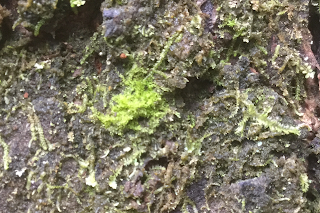I returned to the Nedd-fechan on 20th October, a month and a half after my previous visit when Aphanolejeunea and Kurzia trichoclados were discovered new for Breconshire. This time I was joined by Graham Motley, as we were meeting John Douglass to discuss his lichen survey of the Coedydd Nedd a Mellte SAC. We gathered at the confluence of the Nedd-fechan and Pyrddin, and started our day by searching the north (VC42) bank of the Pyrddin as far as Sgwd Gwladus. Actually this wasn't quite the start of recording, as I had spotted Aphanolejeunea on an oak in the middle of the path (the 2nd record for VC41) and Graham had pointed out Plagiochila bifaria on the same tree. This reminded us of our previous visit to the Pyrddin, when we found Aphanolejeunea new for Glamorgan and South Wales in the mist zone of Sgwd Gwladus. Little did we know what was to follow...
Having met up with John, we proceeded upstream along the Pyrddin. Pretty soon we reached the first, low waterfall, where Graham found a few patches of Aphanolejeunea on a Sycamore. As we approached the big waterfall there was more and more of this Hyperoceanic liverwort - 10 to 20 patches on most of the Ash trunks overhanging the river - whilst a few more acid trunks held Anastrophyllum hellerianum. The Pyrddin is clearly now ideal for Aphanolejeunea, despite this being the southernmost locality for the species in Britain. There is no way of telling whether it has increased recently because there is no indication that anybody has searched those riverside trees in detail before. The valley below Sgwd Gwladus is deep, and the algae, liverworts and lichens on the tree trunks looked pretty well hydrated.
Aphanolejeunea microscopica forming a bright yellow-green patch
alongside larger Lejeunea and Lophocolea
There was more to come. After lunch, we headed up the Nedd-fechan towards Nant-y-llechau: on the opposite bank to where I found last month's Aphanolejeunea and Plagiochila exigua. We descended just upstream of the first waterfall, finding an Oak with Plagiochila bifaria on the way down. Again the riverside Ash trees were covered with algae, lichens and Lejeunea, and pretty soon I spotted the species we had been discussing all day: Drepanolejeunea hamatifolia new for Breconshire. There was a good lot of it - at least 20 small patches with perianths and male bracts, on the twin trunks of a young ash on the riverbank. While I was admiring this colony, Graham wandered downstream a few yards and found Aphanolejeunea and Plagiochila exigua on another slender Ash. Along with last month's finds, this is clearly a major hotspot for oceanic bryophytes.
Microscope pic of Drepanolejeunea (sorry, I forgot my camera in the field), and the adjacent 'lejeunea trees
Coedydd Nedd a Mellte SAC keeps producing new oceanic liverworts 15 years after Graham and I first visited, and I am sure there is more to find because several sections have never been searched. It really is an astonishingly special place. Our next trip will be to the central Mellte, upstream from the area where several bryologists searched in the spring; and then there's the Hepste near Sgwd yr Eira, last visited by us in 2001; and the Sgwd Clun-gwyn area, which has been visited several times but never with mist zones in mind; and Sgwd y Pannwr, and Pont Rhyd-y-cnau, and doubtless other places.



Well done Sam and Graham. Yes, the Nedd Fechan Valley is an astonishingly special place. And I remember you telling me a few years ago Sam, to look out for Drepanolejeunea. Can we now expect these Atlantics to turn up in other suitable places in VC41? I think the rest of us need to get tuned in.
ReplyDeleteI'm honestly not sure, Charles - the Brechfa Forest (Carmarthenshire) Drepanolejeunea was on a willow surrounded by conifers close to a population of Daltonia splachnoides. Both are likely to be spore vagrants from Ireland rather than long-term residents of south Wales. However, the Nedd-fechan holds lots of other Atlantic species in classic Atlantic woodland conditions (rather than the pseudo-Atlantic conditions of conifer forests so beloved of Colura) and I get the feeling that Aphanolejeunea and Drepanolejeunea may be long-term residents of the valley along with the Plagiochila exigua that grows near them (and is an unlikely spore vagrant). Unless a clever scientist does some population genetics on these species and can establish a pattern, we will never know.
ReplyDeleteInspiring stuff - thanks for sharing your exploits.
ReplyDeleteI agree that these are species which would be useful to tune into. My recollection of the seemingly unremarkable Carms Drepanolejeunea site, shown to the BSBI group by Sam, has always made me aware of the possibility that it could be lurking in Glamorgan. I'd love to revisit this specues as-well-as get a feel for Aphanolejeunea, so how about we arrange a visit in the next week or two? I'm fairly flexible with dates.
ReplyDeleteGreat work Sam & Graham - inspirational indeed!